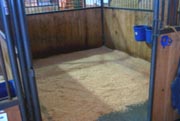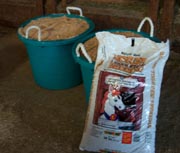Conclusion
 The pelleted bedding material is extremely dry and can absorb more moisture than the fresh sawdust that was used in this project. While the cost of the pelleted bedding is more on an initial basis, individual situations must be considered to determine if it is more economical to use in an operation.
The pelleted bedding material is extremely dry and can absorb more moisture than the fresh sawdust that was used in this project. While the cost of the pelleted bedding is more on an initial basis, individual situations must be considered to determine if it is more economical to use in an operation.
Factors that would impact the decision to use the pellets would be the cost of hauling and storing bedding as well as the cost of manure storage, removal and spreading by the farm. For this project, it was calculated that the pelleted bedding would cost 40% more than the sawdust bedding on a volume basis.
The pelleted bedding comes in waterproof bags that can be stored outside in inclement weather, so a farm would not need the added storage area for clean bedding. Also, the pelleted bedding is delivered to the farm and so labor costs associated with going to the sawmill to pick up and haul the sawdust as well as the truck to transport the clean bedding would not be necessary with pelleted bedding.
Using the pelleted bedding produced only 3/4 of the weight of manure compared to manure from sawdust bedded stalls. Also, 2/3 of the volume of manure was produced from pellet bedded stalls compared to sawdust bedded stalls. Storage structures for manure could be significantly downsized if pelleted bedding were used. In this project, the type of bedding material did not affect the amount of time to actually clean the stall, but labor savings would result from the time to take bedding to the stall.
Horse-keepers need to determine the average amount of bedding they use and manure they remove from stalls to be able to accurately size manure and bedding storage areas. There can be a great variability in the amount of bedding used and manure removed from a horse stall depending on the gender of the horse and variations among the horse-keepers themselves.
 When using pellet bedding, it would be important to follow manufacturer’s recommendations to add a bucket of water to the newly bedded stall to prevent dust build up.
When using pellet bedding, it would be important to follow manufacturer’s recommendations to add a bucket of water to the newly bedded stall to prevent dust build up.
The nutrients captured by the sawdust and pellet bedding materials were essentially the same. The difference in the materials was in the initial moisture level and the resulting decrease in the volume and weight of manure removed from the pellet bedded stalls.
Acknowledgments
Appreciation for the grant funded by the Maine Agriculture Center, which enabled this project to be conducted. Also, appreciation is extended to the University of Maine Witter Animal Science Center for their assistance with this project. Also, thanks and appreciation goes to Sarah Guilmain, who cleaned, bedding and recorded the data for this project.
Thanks go to Perko Feeds, Inc., Exeter, ME for their assistance in obtaining the pelleted product.
Where trade names are used, no discrimination is intended and no endorsement by the University of Maine, the Maine Agricultural Center and the University of Maine Cooperative Extension is implied.
